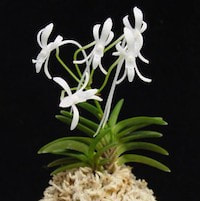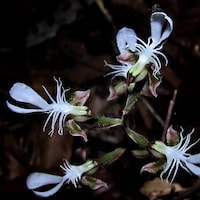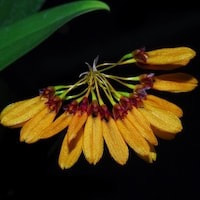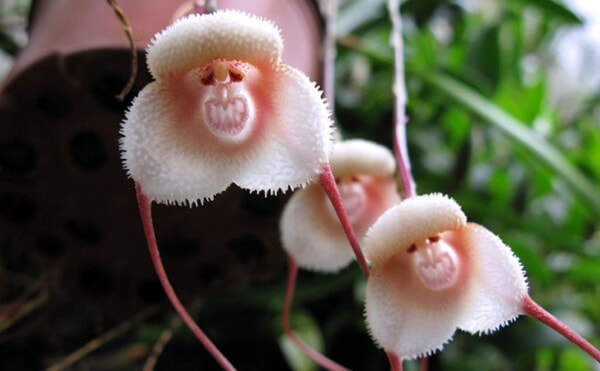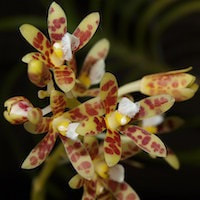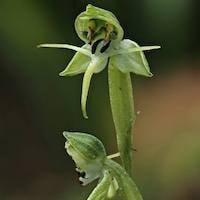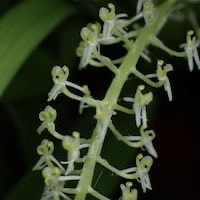Elevate Your Senses with Floral 9 Fragrance Oil
The fragrance composition contains scented notes from various orchid species, each contributing its unique aroma. Here is the research on each orchid scent:
Neofinetia Falcata: Known as the Samurai Orchid, Neofinetia falcata is native to Japan and was among the first orchids grown as houseplants. It is highly valued and sought after, with some sub-varieties selling for exorbitant prices. The flowers of Neofinetia falcata bloom in June and July, releasing a captivating scent. However, extracting the oil from this orchid is challenging due to its flowering patterns.
Anoectochilus roxburghii: This jewel orchid species, also known as Wanna rajah in Sri Lanka and Yaowang in Taiwan, features dark velvety-green/purplish-red leaves with intricate golden veins. Anoectochilus roxburghii is widely used in traditional medicine, particularly in Taiwan and Fujian. It is believed to have numerous medicinal properties, including treating hepatitis, hypertension, cancer, and snakebites. Several medicinal compounds have been identified in this orchid, contributing to its therapeutic scent.
Bulbophyllum retusiusculum: Commonly known as the Yellow Comb Orchid, Bulbophyllum retusiusculum is distributed across regions including China, Myanmar, Thailand, and Malaysia. This orchid is used in Thai herbal medicine as a tonic. Its scent notes add depth and complexity to fragrance compositions.
Calanthe discolor: This orchid, referred to as Xiaji Lan in Chinese, is also known for its medicinal applications. Calanthe discolor is used in traditional herbal medicine to improve blood flow, treat skin ulcers, abscesses, rheumatism, and bone pain. The orchid contains compounds such as calanthoside, glucosides, and phenanthrenes, which contribute to its distinctive scent.
Dipodium pandanum: Dipodium pandanum is a widespread orchid found in lowland rainforests across regions including Papua New Guinea, Borneo, the Philippines, and Queensland. While its scent may vary, this orchid adds a unique note to fragrance compositions.
Habenaria diphylla: Habenaria diphylla is a species found in damp locations and rocks in forests or valleys. Its flowers are used in traditional medicine in India and Thailand to treat asthma and insect bites, respectively. The scent of Habenaria diphylla adds a touch of freshness and floral complexity.
Liparis viridiflora: This orchid, known as Luhuayanger Lan in Chinese, has cylindrical pseudobulbs and is widely distributed across Southeast Asia. It flowers from September to December in China and has herbal uses in treating coughs, poisoning, fever, and fractures. The scent of Liparis viridiflora combines green and floral notes, adding a natural and invigorating aspect to fragrances.
In addition to the orchid scents, other notes present in the fragrance composition include spicy, fruity, floral, lily, patchouli, precious amber, warm woods, and silk tree. These additional scents contribute to the overall complexity and allure of the perfume, creating a captivating olfactory experience.
Neofinetia Falcata: Known as the Samurai Orchid, Neofinetia falcata is native to Japan and was among the first orchids grown as houseplants. It is highly valued and sought after, with some sub-varieties selling for exorbitant prices. The flowers of Neofinetia falcata bloom in June and July, releasing a captivating scent. However, extracting the oil from this orchid is challenging due to its flowering patterns.
Anoectochilus roxburghii: This jewel orchid species, also known as Wanna rajah in Sri Lanka and Yaowang in Taiwan, features dark velvety-green/purplish-red leaves with intricate golden veins. Anoectochilus roxburghii is widely used in traditional medicine, particularly in Taiwan and Fujian. It is believed to have numerous medicinal properties, including treating hepatitis, hypertension, cancer, and snakebites. Several medicinal compounds have been identified in this orchid, contributing to its therapeutic scent.
Bulbophyllum retusiusculum: Commonly known as the Yellow Comb Orchid, Bulbophyllum retusiusculum is distributed across regions including China, Myanmar, Thailand, and Malaysia. This orchid is used in Thai herbal medicine as a tonic. Its scent notes add depth and complexity to fragrance compositions.
Calanthe discolor: This orchid, referred to as Xiaji Lan in Chinese, is also known for its medicinal applications. Calanthe discolor is used in traditional herbal medicine to improve blood flow, treat skin ulcers, abscesses, rheumatism, and bone pain. The orchid contains compounds such as calanthoside, glucosides, and phenanthrenes, which contribute to its distinctive scent.
Dipodium pandanum: Dipodium pandanum is a widespread orchid found in lowland rainforests across regions including Papua New Guinea, Borneo, the Philippines, and Queensland. While its scent may vary, this orchid adds a unique note to fragrance compositions.
Habenaria diphylla: Habenaria diphylla is a species found in damp locations and rocks in forests or valleys. Its flowers are used in traditional medicine in India and Thailand to treat asthma and insect bites, respectively. The scent of Habenaria diphylla adds a touch of freshness and floral complexity.
Liparis viridiflora: This orchid, known as Luhuayanger Lan in Chinese, has cylindrical pseudobulbs and is widely distributed across Southeast Asia. It flowers from September to December in China and has herbal uses in treating coughs, poisoning, fever, and fractures. The scent of Liparis viridiflora combines green and floral notes, adding a natural and invigorating aspect to fragrances.
In addition to the orchid scents, other notes present in the fragrance composition include spicy, fruity, floral, lily, patchouli, precious amber, warm woods, and silk tree. These additional scents contribute to the overall complexity and allure of the perfume, creating a captivating olfactory experience.
Download the guided mediation that works best with this Orchid fragrance oil
| women_floral_essential_oil_orchi_00009.mp3 | |
| File Size: | 171870 kb |
| File Type: | mp3 |
The Power of Orchids Unleashed
Contains Scented Notes of following in various proportions:
Native Singaporean Orchid notes: Neofinetia Falcata
|
Neofinetia Falcata - Used in Floral 9 (Women) for Team building Perfume workshop
Neofinetia falcata, also known as the Samurai Orchid, is a highly prized orchid variety used in Floral 9 (Women) for Team building Perfume workshop. It holds the distinction of being the first orchid ever cultivated as a house plant in Japan during the 1600s. This orchid is renowned for its rarity, with certain sub-varieties fetching astonishing prices of up to $100,000 or more. Neofinetia falcata typically blooms in June and July, exhibiting its captivating flowers during the dusk and dawn hours. However, extracting oil from this orchid poses a significant challenge due to its specific flowering patterns. Despite being a non-native Singaporean orchid, its exotic nature and unique characteristics have made it a valuable addition to the fragrance composition, enhancing its allure and appeal. |
Therapeutic Orchid notes:
|
Anoectochilus roxburghii (Wall.) Lindl.
Sri Lankan name: Wanna rajah (“that which glistens in the woods”). Taiwanese name:Yaowang (King medicine) Anoectochilus roxburghii (Wall.) Lindl., known as Wanna rajah in Sri Lanka and Yaowang (King medicine) in Taiwan, is a remarkable orchid with dark velvety-green/purplish-red leaves adorned with a complex network of golden veins. This jewel orchid thrives in humus-rich soil across continental East Asia, including China, Vietnam, Laos, Myanmar, the Himalayan foothills, and Sri Lanka. This orchid holds significant medicinal value and is widely utilized in traditional practices. In Taiwan and Fujian, it enjoys widespread provincial usage as a medicinal herb. Anoectochilus roxburghii is employed in the treatment of various conditions such as hepatitis, splenic disorders, hypertension, cancer, tuberculosis, impotence, fever, snake bites, and even slow development in children. It is highly regarded as a panacea for numerous ailments in Fujian, China, and finds application in Indian medicines as well. Extensive research has led to the identification of several therapeutic compounds within this orchid. Notably, Zhonghua Bencau Kinsenoside, a glycoside and major component, exhibits anti-glycemic activity. Other medicinal compounds present include beta-D-glucopyranosyl-3R)-hydroxybutanolide, stearic acid, palmitic acid, beta-sitosterol, succinic acid, p-hydroxybenzylaldehyde, daucosterol, methyl 4-beta-D-glucopyranosyl-hutanoate, p-hydroxycinnamic acid, 0-hydroxy phenol, ferulic acid, quercetin, daucosterol, cirsilineol, p-hydroxybenzylaldehyde, two novel sorghumol triterpenoid acyl esters, a new alkaloid called anoecochine, and a known triterpenoid called soghumol. The diverse array of therapeutic compounds found within Anoectochilus roxburghii highlights its potential in traditional medicine and underscores its importance as a valuable natural resource. |
|
Bulbophyllum retusiusculum
Chinese name: Yellow Comb Orchid Thai name (in Ubon Rachthani): Ma tak khok Bulbophyllum retusiusculum, commonly known as the Yellow Comb Orchid, is a species widely distributed across various regions. It can be found in areas ranging from Hunan, Taiwan, Hainan, Sichuan, and Yunnan in China, to Myanmar, Thailand, Indochina, Peninsular Malaysia, Nepal, Sikkim, and Bhutan. In the Ubon Rachthani region of Thailand, this orchid is known as "Ma tak khok." Thai herbalists recognize its medicinal properties and utilize the whole plant to create tonics. The specific benefits and uses of this orchid in traditional Thai medicine may vary, but it is valued for its therapeutic properties. Bulbophyllum retusiusculum's wide distribution across different regions underscores its significance in traditional herbal practices. Its utilization as a tonic in Thai traditional medicine showcases its potential health benefits and highlights the importance of this orchid within local healing traditions. |
|
Calanthe discolor Lindl.
Chinese names: Xiaji Lan (prawn spine orchid) Calanthe discolor Lindl., commonly known as the Prawn Spine Orchid, is a species of orchid found in China. It is known by various names in Chinese, including Xiaji Lan and Jiuzilianhuancao. Its unique Chinese names such as "Jiuzilianhuancao" also refer to Calanthe tricarinata and depict the distinctive characteristics of this orchid. The phytochemistry of Calanthe discolor has been studied, revealing the presence of several compounds with beneficial properties. Four compounds found in this orchid have been shown to improve blood flow through the skin and promote hair growth. These compounds are calanthoside (indole, S,O-bisdesmoside), glucoindican, calaliukiueno-side, and calaphenanthrenol. Additionally, other compounds such as tryptanthrin, indirubin, isatin, and indicant have been identified in Calanthe discolor. In traditional herbal usage, the entire plant, including the roots and stem, is utilized to enhance blood circulation and dissolve extravasated blood. Calanthe discolor is used to treat various conditions such as abscesses, scrofula, rheumatism, bone pain, and traumatic injuries. It is also employed for the treatment of skin ulcers and hemorrhoids. The herb is commonly obtained from Huadong, which is located in Guangdong Province, China. Its traditional usage highlights its role in improving blood circulation and its potential as a remedy for various ailments. The distinct characteristics and therapeutic properties of Calanthe discolor make it an important plant within traditional Chinese medicine practices. |
|
Dipodium pandanum F.M.Bailey syn. Dipodium pictum (Lindl.) Rchb. f.
Dipodium pandanum, also known as Dipodium pictum, is a species of orchid found in the lowland rainforests of Papua New Guinea and other regions in Southeast Asia. The generic name "Dipodium" is derived from the Greek words "di" meaning two, and "podion" meaning foot, referring to the twin stipes that hold up the pollinia. This orchid species can be found as an epiphyte, terrestrial, or saxicolous plant. It is commonly found in the lowland rainforests of Papua New Guinea, and its distribution extends eastwards and southwards from Borneo to the Philippines, Sulawesi, Java, the British Solomon Islands, and Queensland. In terms of herbal usage, the leaves of Dipodium pandanum are used to make a tea that is employed in the treatment of respiratory infections in Bougainville, Papua New Guinea. The tea derived from the leaves of this orchid species is utilized in traditional medicine practices to alleviate respiratory ailments. Dipodium pandanum's natural habitat and its traditional usage in herbal medicine highlight its significance in local cultures and traditional healing practices. |
|
Habenaria diphylla (Nimmo) Dalzel Syn. Habenaria humistrata Rolfe ex Downie
Thai name: Tupmup mot lin Habenaria diphylla, also known as Habenaria humistrata, is an orchid species found in damp locations and on rocks in forests and valleys. It blooms in June in China and from July to September, with some occurrences in August, in India. In terms of herbal usage, the whole plant of Habenaria diphylla is utilized in Thailand for the treatment of insect bites. The flowers of this orchid species, known as Jeevahi Purusharatna, are popularly used in the Western Ghats to treat asthma. The presence of Habenaria diphylla in these regions and its traditional usage in herbal medicine demonstrate its importance in local cultures and traditional healing practices. |
|
Liparis viridiflora (Blume) Lindl.
Chinese names: Luhuayanger Lan (green flower sheep ear orchid), Changjing-yangersuan (long stem sheep ear garlic) Liparis viridiflora, also known as the green flower sheep ear orchid, is a plant species with cylindrical pseudobulbs. It blooms in September to December in China, November in Assam and Sikkim, and from August to September in the Western Ghats. This orchid species is highly prevalent and widely distributed across various regions. It can be found from Sri Lanka and the tropical Himalayas to southern China, Southeast Asia, and the Pacific Islands. In terms of herbal usage, the stems of Liparis viridiflora are utilized in traditional medicine to treat coughs, poisoning, fever, and fractures. The roots of this orchid species are also used for the treatment of hernia. The diverse range of applications for Liparis viridiflora in traditional medicine highlights its significance in indigenous healing practices and showcases the potential medicinal properties associated with this plant. |
Other scent note
Spicy note, fruit mix, floral mix, hint of lily, while patchouli, Precious amber, warm woods, Silk tree
Scentopia Library Reference ingredient
Forget me not - Check details at Scentopia's scent library
Join Scentopia's wonderful orchid scent crafting, fragrance tour, bridal shower or corporate team building which includes perfume making onsite and offsite, beach activities and more. We also serve primary school learning journey, secondary students and pupil on industrial excursions. Know more about our orchids perfume bar or therapeutic orchid scents and other wellness aromas. Conatct Perfume workshop or book a scent crafting session here.
